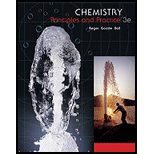
Concept explainers
(a)
Interpretation:
Empirical formula of the compound has to be calculated.
Concept Introduction:
Empirical formula is the one that can be determined from the molar mass of the elements that is present in the compound and the mass percentage of the elements. The mass percentage of the elements present in the compound is converted into the moles of each element considering the molar mass of each element. The relative number of moles for each type of atoms is found out finally.
Molecular formula of a compound can be found if the empirical formula and molar mass of the compound is known. The molar mass of compound is divided by the molar mass of the empirical formula in order to obtain the factor which is multiplied with the coefficients of empirical formula in order to obtain the molecular formula.
(a)
Answer to Problem 12.105QE
Empirical formula of the compound is
Explanation of Solution
Percentage composition of the compound is given as
Moles of sodium:
Moles of carbon:
Moles of oxygen:
Empirical formula can be obtained by dividing the moles of each element with the least mole. This is done as follows;
Therefore, the ratio of the element can be given as
Thus the empirical formula will be
(b)
Interpretation:
The formula of the white solid has to be given and the equation for the dissociation in water has to be written.
(b)
Explanation of Solution
It is given that the solution is made by dissolving
Thus the molality of water is
Moles of solvent is calculated as follows;
Molar mass of the compound is calculated using the moles as follows;
Molar mass of the empirical formula is calculated as shown below;
Molecular formula can be calculated from the molar mass and empirical mass as shown below;
Therefore, the formula of the white solid is given as shown below;
Thus the formula of the white solid is
Dissolution of
Want to see more full solutions like this?
Chapter 12 Solutions
Chemistry
- Calcium chloride, CaCl2, has been used to melt ice from roadways. Given that the saturated solution is 32% CaCl2 by mass, estimate the freezing point.arrow_forwardAn aluminum-containing compound has the empirical formula (C2HS)2AIF. Find the molecular formula if 0.448 g of the compound dissolved in 23.46 g of benzene has a freezing point of 5.265 C.arrow_forwardWhat is the freezing point and normal boiling point of a solution made by adding 39 mL of acetone, C3H6O, to 225 mL of water? The densities of acetone and water are 0.790 g/cm3 and 1.00 g/cm3, respectively.arrow_forward
- 6-111 As noted in Section 6-8C, the amount of external pressure that must be applied to a more concentrated solution to stop the passage of solvent molecules across a semipermeable membrane is known as the osmotic pressure The osmotic pressure obeys a law similar in form to the ideal gas law (discussed in Section 5-4), where Substituting for pressure and solving for osmotic pressures gives the following equation: RT MRT, where M is the concentration or molarity of the solution. (a) Determine the osmotic pressure at 25°C of a 0.0020 M sucrose (C12H22O11) solution. (b) Seawater contains 3.4 g of salts for every liter of solution. Assuming the solute consists entirely of NaCl (and complete dissociation of the NaCI salt), calculate the osmotic pressure of seawater at 25°C. (c) The average osmotic pressure of blood is 7.7 atm at 25°C. What concentration of glucose (C6H12O6) will be isotonic with blood? (d) Lysozyme is an enzyme that breaks bacterial cell walls. A solution containing 0.150 g of this enzyme in 210. mL of solution has an osmotic pressure of 0.953 torr at 25°C. What is the molar mass of lysozyme? (e) The osmotic pressure of an aqueous solution of a certain protein was measured in order to determine the protein's molar mass. The solution contained 3.50 mg of protein dissolved in sufficient water to form 5.00 mL of solution. The osmotic pressure of the solution at 25°C was found to be 1.54 torr. Calculate the molar mass of the protein.arrow_forwardInsulin is a hormone responsible for the regulation of glucose levels in the blood. An aqueous solution of insulin has an osmotic pressure of 2.5 mm Hg at 25C. It is prepared by dissolving 0.100 g of insulin in enough water to make 125 mL of solution. What is the molar mass of insulin?arrow_forward
 Chemistry: Principles and ReactionsChemistryISBN:9781305079373Author:William L. Masterton, Cecile N. HurleyPublisher:Cengage Learning
Chemistry: Principles and ReactionsChemistryISBN:9781305079373Author:William L. Masterton, Cecile N. HurleyPublisher:Cengage Learning Chemistry: The Molecular ScienceChemistryISBN:9781285199047Author:John W. Moore, Conrad L. StanitskiPublisher:Cengage Learning
Chemistry: The Molecular ScienceChemistryISBN:9781285199047Author:John W. Moore, Conrad L. StanitskiPublisher:Cengage Learning Chemistry & Chemical ReactivityChemistryISBN:9781133949640Author:John C. Kotz, Paul M. Treichel, John Townsend, David TreichelPublisher:Cengage Learning
Chemistry & Chemical ReactivityChemistryISBN:9781133949640Author:John C. Kotz, Paul M. Treichel, John Townsend, David TreichelPublisher:Cengage Learning Chemistry & Chemical ReactivityChemistryISBN:9781337399074Author:John C. Kotz, Paul M. Treichel, John Townsend, David TreichelPublisher:Cengage Learning
Chemistry & Chemical ReactivityChemistryISBN:9781337399074Author:John C. Kotz, Paul M. Treichel, John Townsend, David TreichelPublisher:Cengage Learning General Chemistry - Standalone book (MindTap Cour...ChemistryISBN:9781305580343Author:Steven D. Gammon, Ebbing, Darrell Ebbing, Steven D., Darrell; Gammon, Darrell Ebbing; Steven D. Gammon, Darrell D.; Gammon, Ebbing; Steven D. Gammon; DarrellPublisher:Cengage Learning
General Chemistry - Standalone book (MindTap Cour...ChemistryISBN:9781305580343Author:Steven D. Gammon, Ebbing, Darrell Ebbing, Steven D., Darrell; Gammon, Darrell Ebbing; Steven D. Gammon, Darrell D.; Gammon, Ebbing; Steven D. Gammon; DarrellPublisher:Cengage Learning General, Organic, and Biological ChemistryChemistryISBN:9781285853918Author:H. Stephen StokerPublisher:Cengage Learning
General, Organic, and Biological ChemistryChemistryISBN:9781285853918Author:H. Stephen StokerPublisher:Cengage Learning





